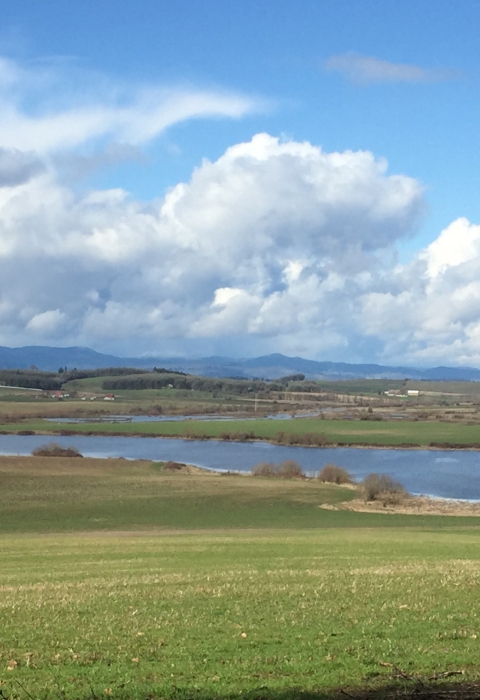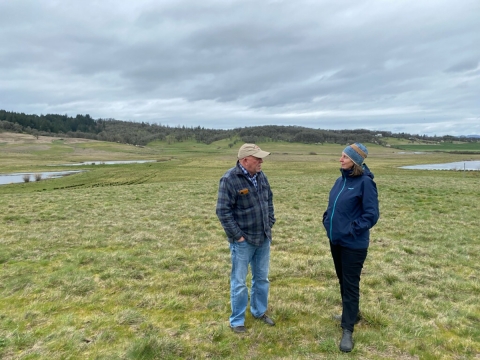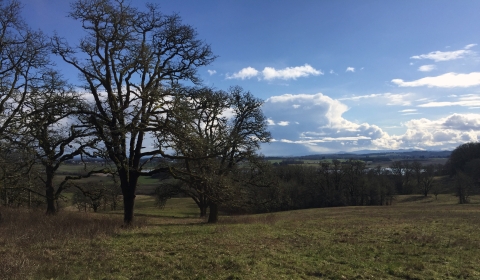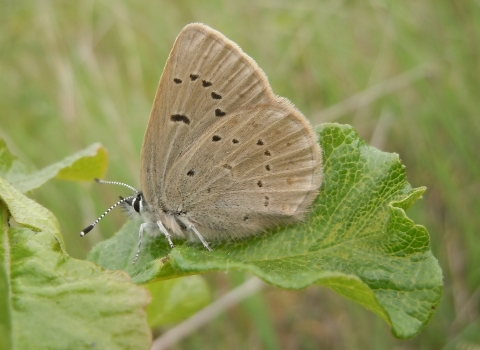This year is the 50th anniversary of the Endangered Species Act, a law that has been a powerful catalyst for conservation of America’s most treasured fish, wildlife, plants and their habitats. In the Pacific Region, our Tribes, state and federal agencies, and partners have joined with our dedicated staff to be the driving force behind the successes we share and the strength ensuring we can address the challenges ahead. Celebrate this milestone with us in this collection of stories as we reflect on past successes, assess current challenges, and envision an equally bright future for the next 50 years and beyond.
This story was originally published in 2017.
Graham Evans-Peters sees the past, present and future of conservation when he looks across the fields at Baskett Slough National Wildlife Refuge.
Standing on Baskett Butte’s south slope, the Baskett Slough refuge manager deftly points out key features and explains how the U.S. Fish and Wildlife Service brings together farmers and landowners with imperiled native wildlife.
Immediately in front of us is a reminder of the distant past: A remnant prairie with white oak habitat that has never been plowed. This native prairie supports Kincaid’s lupine, which is the host plant for the endangered Fender’s blue butterfly.
Further down the hill is a former agriculture field that was restored to native prairie just three short years ago in 2014.
“Native prairie is a really imperiled habitat in the Willamette Valley at less than 1% of its historic range,” Graham tells me as we walk. “That field mainly has been planted with a couple of native bunch grasses and dozens of native wildflowers, which is great for a whole host of wildlife species around here.”
At the bottom, close to Dusky Marsh, is an interesting (but little known) aspect of the National Wildlife Refuge System – collaborative conservation in the form of a cooperative farming program.
“We have an agreement with local farmers to come here and plant types of grasses or small grains for the benefit of providing winter forage for geese,” Graham says. “The farmers don’t pay a rent or any fees to use the acreage. They create unlimited browse for the waterfowl that overwinter here, and then the farmers harvest the rest in the spring. That amount is generally about half of the normal yield, but they don’t have costs other than the seed, and fuel for planting and harvesting. It’s a win-win for waterfowl and farmers, which makes it a huge success for the refuge since it was created as a way to protect the dusky Canada goose and other waterfowl. This program helps protect their future while minimizing the refuge’s costs.”
We walk along the ridge for another quarter mile and stop under a huge Oregon white oak tree overlooking the butte’s north view, which includes Morgan Lake.
This is where some intense habitat management is going on for the imperiled Oregon white oak. Oak savannas and prairies once covered about 1.8 million acres, or about half of the Willamette Valley. Today, only about 47,000 acres remain.
The suppression of fire following settlement in the Willamette Valley has dramatically altered oak woodlands and savanna. The refuge is selectively restoring these areas by removing invading Douglas fir trees that would eventually shade out the oaks. In addition, undergrowth is thinned to maintain an open grassland understory. This all benefits a multitude of native species while encouraging the young oaks to grow into mighty oaks.
“These majestic white oaks are important to the ecosystem here,” Graham says. “They help provide food for many species of wildlife, increase native insect populations which are an important food source, and they offer nest, den and roosting sites for wildlife. We do a lot of intense habitat management around this area.”
The sound of an incoming flock of cackling geese interrupts our conversation. We watch them land and begin feeding in the bottomlands near Morgan Lake. Graham points to our next destination out beyond the geese and the lake – Van Duzer Vineyards.
While a winery is a great place to end a day in the field, that isn’t our purpose on this day. We head there for the butterflies.
Vineyard manager Bruce Sonnen and U.S. Fish and Wildlife Service Partners for Fish and Wildlife biologist Chris Seal meet us at the entrance as the rain starts to come down. We scurry under the covered dock to wait out the cold rain.
Bruce’s primary responsibility is to grow 84 acres worth of grapes for the Van Duzer wines. But it’s what they do on the other 22 acres that make the winery extra special. By working with the Partner’s program, Van Duzer Vineyards has created a habitat haven for endangered Fender’s blue butterflies, Kincaid’s lupine, acorn woodpeckers, Oregon white oaks and many other native species.
“It only makes sense to do this on our unused space,” Bruce says. As if on cue, the rain stops and blue skies appear overhead. “We can’t use these areas for grape production due to the soil and topography in those areas. Why wouldn’t we work to help native wildlife?”
The Service started working with Van Duzer about eight years ago. As with most conservation projects, the initial results are slow. Then one day in 2014, it finally happened.
“The day we found our first Fender’s blue butterfly was amazing,” Bruce tells us. “The main thing I remember is seeing four grown men with butterfly nets jumping about in the field, excited because we had finally found a little blue butterfly. It was a sight to see. Since finding that first Fender’s butterfly in 2014, the population has increased 400% annually. It’s proof that if you build it, they will come.”
The excitement from that day still rings through in Bruce’s voice. He’s genuinely excited to help native wildlife in the Willamette Valley.
Just like Graham at Baskett Slough, Bruce also sees the past, present and future of conservation in his fields. And that’s something to which we can all raise a toast.







